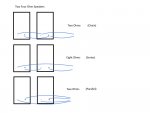YanKleber
Retired
Hi,
I am a bit confused about the calculation of stereo system impedance.
I have two pairs of 4 ohms loudspeakers and currently don't have any stereo system (they are idle) but I plan to buy one in the future and would like to connect all the four speakers on it.
Let me know if I am assuming it correctly: if I connect a pair on system 'A' and the other pair on system 'B' I will get a parallel association and therefore will end with a total impedance of 2 ohms, right? I think that it is a too low impedance for mostly of systems, so I am not going for it.
If instead I hook both pairs in the same system (A or B) am I correct to assume that they will be set in series and therefore the total impedance will be 8 ohms?
Thanks!
I am a bit confused about the calculation of stereo system impedance.
I have two pairs of 4 ohms loudspeakers and currently don't have any stereo system (they are idle) but I plan to buy one in the future and would like to connect all the four speakers on it.
Let me know if I am assuming it correctly: if I connect a pair on system 'A' and the other pair on system 'B' I will get a parallel association and therefore will end with a total impedance of 2 ohms, right? I think that it is a too low impedance for mostly of systems, so I am not going for it.
If instead I hook both pairs in the same system (A or B) am I correct to assume that they will be set in series and therefore the total impedance will be 8 ohms?
Thanks!




